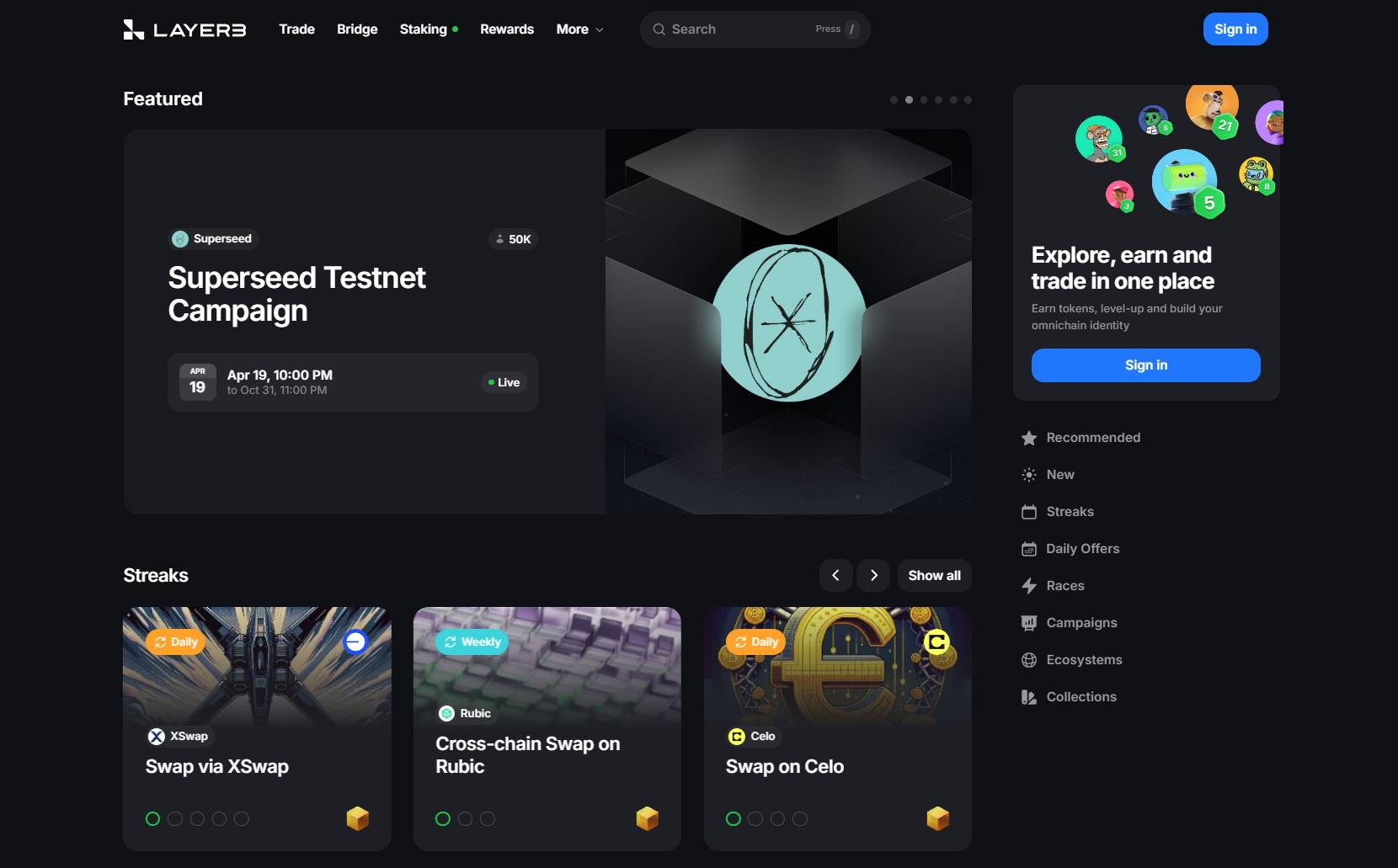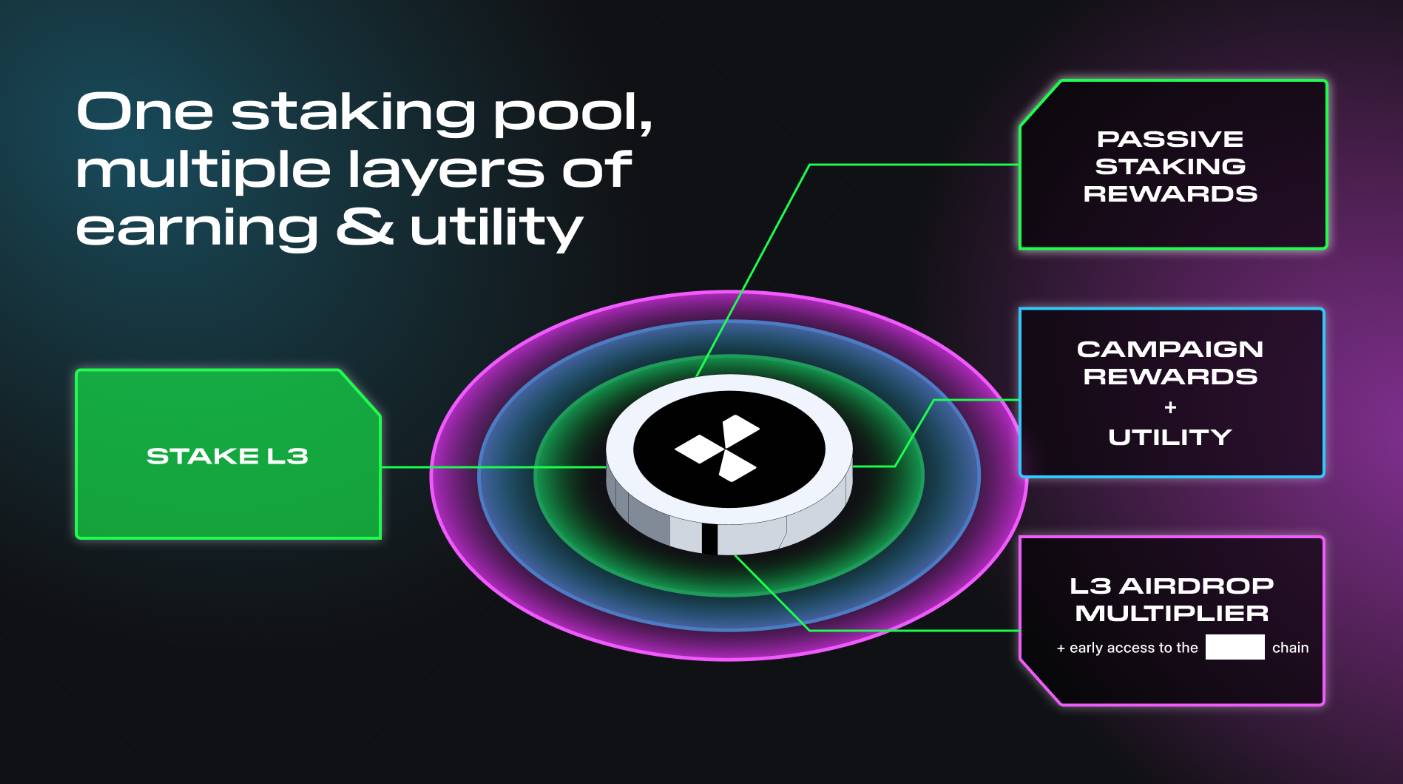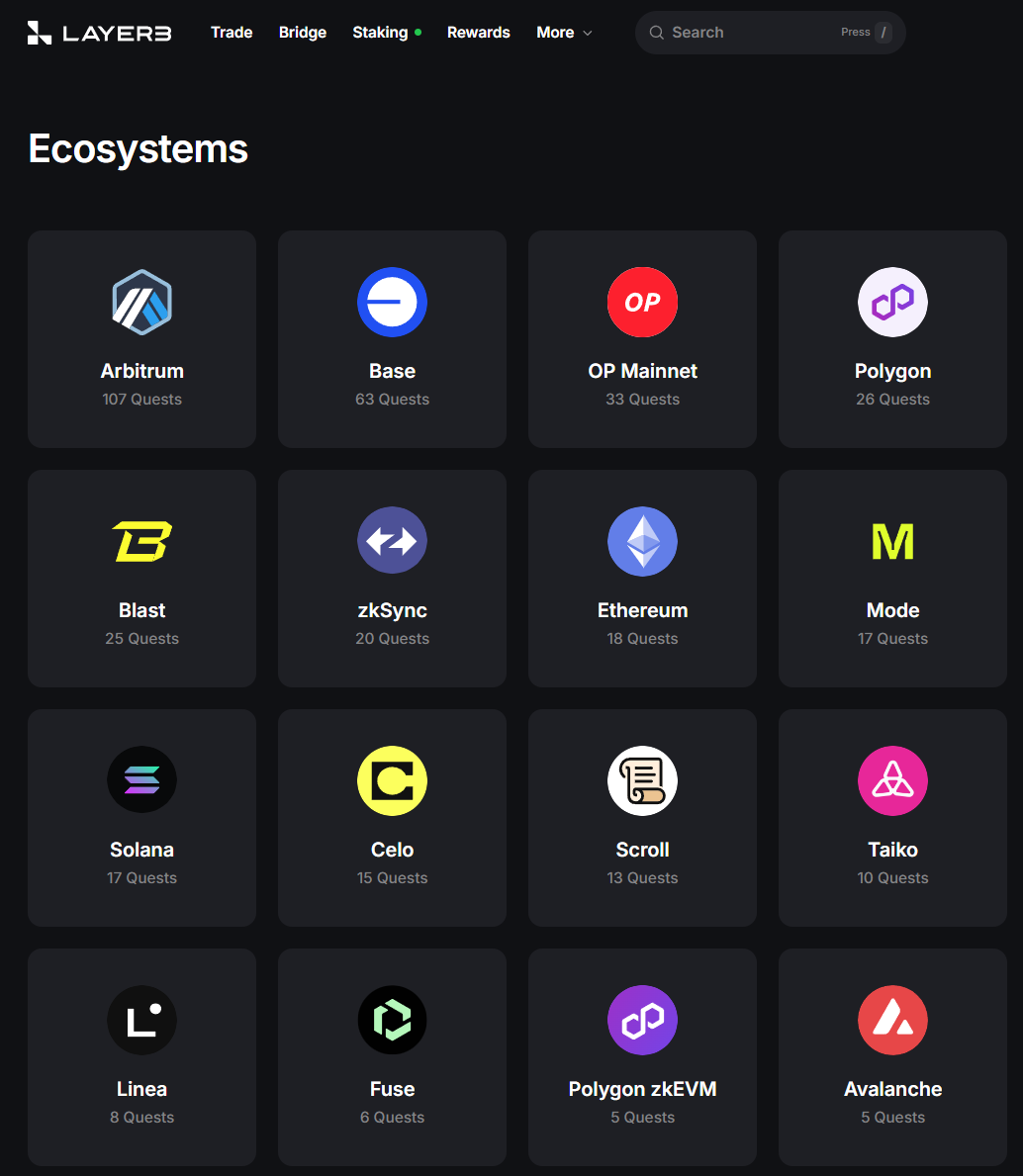Layer3 has generated nearly $10 million in revenue, serving hundreds of thousands of users monthly.
Original: Block Media
Layer 3 (L3) aims to make Web3 technology more popular and user-friendly. Our goal is to build a decentralized ecosystem where users can more directly own value by addressing structural issues in existing platform distribution and helping them actively participate in the Web3 ecosystem.
Layer3's main goals include improving user experience, increasing user engagement, gamification elements, and decentralized governance. To achieve this, we make complex blockchain technology easier to learn through gamified tasks and rewards, and encourage user participation through reward systems and governance.
Currently, Layer 3 has built distribution infrastructure used by over 100 cryptocurrency projects, including Uniswap, Base, Arbitrum, Linea, Polygon, and Celo. It has over 3 million independent users in 120 countries, supporting 25 blockchains, including the EVM and Solana ecosystems.
In June of this year, Layer3 raised $15 million in Series A funding, accumulating a total of $21 million in funding since 2021. Afterward, we plan to provide faster and cheaper services through collaborations with various Layer 2 solutions. Block Media met with Layer 3 co-founder and CEO Dariya Khojasteh to understand their dream of becoming the "Google of Web 3."
Q: Please briefly introduce Layer 3.
A: I am the co-founder and CEO of Layer 3. We are building a comprehensive solution to help cryptocurrency protocols and users navigate the industry. The goal is to improve the efficiency of cryptocurrency distribution through the Layer3 protocol and build open-source tools for users to create the best consumption platform, identity positioning, and incentive distribution.

Full-chain identity, token distribution, and incentive infrastructure
Q: What are the main issues Layer3 is currently focusing on? I am particularly curious about your goals in the blockchain and network infrastructure-related fields.
A: One of the main issues Layer3 aims to address is that blockchain teams do not have the distribution efficiency that internet builders get from Facebook or Google ads.
New teams need to consider all deployment strategies from the start. We need to find a way to collect Twitter followers and distribute tokens to the right users. In this process, there is inefficiency that hinders overall growth.
Therefore, we are developing and optimizing native cryptographic solutions to address these issues. We have created a structure that allows users to understand projects they are interested in and acquire tokens. This enables protocols and blockchain teams to acquire the users they want and optimize long-term user acquisition rather than short-term speculation.
Q: There seems to be a lot of understanding and criticism of marketing for Web 3 projects. How does Layer3 address this issue?
A: Currently, there is no platform optimized for using cryptocurrencies in the Web3 ecosystem. Layer3 is dedicated to creating an integrated ecosystem where users can trade cryptocurrencies, discover new projects, and earn tokens.
One huge advantage of Layer3 is that all these functions are consolidated in one place. Any consumer interested in cryptocurrencies can easily find elements of interest on this platform, and the process is structured in a very engaging way.
Ultimately, cryptocurrency users want fun and profit. If you can provide both services on one platform, users will stay and come back time and time again. In this regard, I believe Layer3 is a very influential product. It is not easy to get people to visit multiple times a day and continuously return for hundreds of days.
If you look at the Layer 3 leaderboard, you can find users in the top 100 who have visited for 100 days, 200 days, 300 days, and even 800 days or more consecutively. This level of sustained engagement is very rare in the Web3 ecosystem.
Typical internet companies are very aware of how much their customers contribute to the company. If a customer spends $100 at your company, attracting them for less is a good business outcome. However, the cryptocurrency industry lacks this long-term perspective.
For example, when we collaborated with Base, we estimated that the long-term value of a user might be $1020, even though we do not know what the ecosystem will look like in 10 years. If that's the case, Base can devise a strategy to attract users for less than $1020. This ensures successful business outcomes and brings valuable ownership to users.
If this is not done, both users and protocols will suffer losses, potentially harming the entire industry. Therefore, we are taking this approach to create a sustainable ecosystem.
Q: It is said that Layer 3's goal is to be a "Web3 super channel, Web3 Google." As Layer 3 may develop into a centralized platform like Google or Facebook, how do you plan to maintain decentralization?
A: That's a good question. We seek to decentralize the attention economy currently driven by platforms like Meta and Google.
To achieve this, we are building a Layer3-centric platform. The platform is the interface that users visit every day, designed to reward users directly for spending time or investing funds on it.
The tokens users earn in the Layer 3 ecosystem are based on the time and attention they spend on the platform. For example, when a user discovers and uses the XYZ protocol through Layer3, they will receive that protocol's token. In this respect, it is very different from Google or Facebook, where huge profits are made from user attention. At Layer3, users make money.
Furthermore, our biggest goal is to decentralize the attention economy of the internet's large-scale, centralized platform model. Layer3 is at the center, but users gain most of the value, and that value is something they can manage. This can be considered an innovation compared to existing internet business models.
Q: In the case of multi-chain, multi-protocol, what is Layer3's strategy? What are your plans for supporting the OmniChain protocol?
A: Our protocol is compatible with all EVM (Ethereum Virtual Machine) chains. Since deploying new chains is very easy nowadays, we support the chain from the day it launches and the teams building in that chain's ecosystem, which is important.
For users, it gives them the opportunity to explore everything in the new ecosystem, find alpha, and earn tokens. For this, we take a full-chain approach. There may be many non-EVM chains in the coming years, and we are preparing to ensure that our users get as much value as possible from these chains from day one.
There will never be a situation where Layer 3 is not in a new chain whenever it appears. That's our goal.
Q: How will the L3 token be used within the platform?
A: In the Layer3 ecosystem, layered staking is a way to align incentive measures with long-term user retention. People with L3 tokens have access to more parts of the ecosystem than those without L3 tokens. Additionally, staking L3 tokens allows access to an even more expansive ecosystem.
This provides an opportunity for all users to participate in Layer3 while ensuring that those most aligned with the values receive the greatest long-term benefits. Many people complain that airdrops diminish the consumer experience of cryptocurrencies, as they often lead to short-term gains, token dumping, and project extinction.
We focus on providing real value to users. We care about how much long-term contribution they can make to our protocol and how long we can sustain this ecosystem.

Layer3 staking token economics
In the end, we believe that long-term adjustments to incentive measures are the right model for any ecosystem. Ultimately, this is the source of token utility.
Q: How has the feedback been after the launch of the L3 token? I'm curious if there are any concerns related to token economics.
A: Currently, the circulating market value of the L3 token is around $20 million, with a trading volume of around $3 million (as of August 23rd, Korean time). This is a very large difference in numbers. We are still studying various factors as the reason for this high interest.
I think this is because consumers using the L3 token really like the utility of the token. I believe the fact that you can use the token immediately upon receiving it for the first time makes it very attractive. It seems to be popular because it is widely used on various exchanges, has many practical applications that consumers can actually use, and because these applications are provided across three layers.
We value user feedback very much. In cryptocurrency projects, we believe we may be the best at analyzing what content users find interesting and what they consider important.
We have received a variety of user feedback, some positive and some negative, but most users want to see more activities and experiences. One of these is the Launchpad.
The Launchpad is meaningful, especially in issuing tokens in a centralized exchange environment and providing services to those issuing these tokens. Existing methods involve simple farming or passive token staking.
However, the Launchpad built by Layer3 is designed to provide an immersive experience for users to experience the project before the token is issued. This means that not only those staking will receive tokens, but those who truly want to participate in the project will receive tokens.
Q: What potential new partnerships and future plans can Layer 3 users expect?
Among the upcoming partners, there are two particularly anticipated ones. One is the launch of a highly anticipated blockchain, and the other is an infrastructure project that has recently received substantial funding support. These projects have garnered widespread attention on social media and among consumers, and we plan to promote the entire ecosystem they support. Both of these projects are preparing to launch on Layer3's Launchpad.

Layer 3 introductory ecosystem list
We also plan to deploy on non-EVM chains. The goal is to allow users from different ecosystems to enjoy all the benefits of Layer 3. We also plan to move tokens to these chains so that users with liquidity only in that ecosystem can stake their tokens and receive the same utility as EVM users.
Q: Please convey your final words to investors in the Korean Web3 ecosystem.
A: Layer3 has generated nearly $10 million in revenue, issued approximately 30 million tokens (CUBEs), and distributed incentives in the process. We serve hundreds of thousands of users monthly.
So far, over 110 million Layer 3 tokens have been staked, increasing the demand for exchanges. This is because you need Layer 3 tokens to stake them and access the utilities within the ecosystem.
In the future, I believe that as we collaborate with more projects, onboard new users into the ecosystem, and deploy to more chains, we will be able to develop the platform and truly achieve the goal of becoming the "Google of Web 3."
If anyone has not yet used Layer 3, registering and giving it a try is a good idea. I also hope you can provide me with some feedback. If you have any questions about Layer 3, please feel free to ask. We will work together to help Koreans participate in the Layer 3 ecosystem.
免责声明:本文章仅代表作者个人观点,不代表本平台的立场和观点。本文章仅供信息分享,不构成对任何人的任何投资建议。用户与作者之间的任何争议,与本平台无关。如网页中刊载的文章或图片涉及侵权,请提供相关的权利证明和身份证明发送邮件到support@aicoin.com,本平台相关工作人员将会进行核查。




